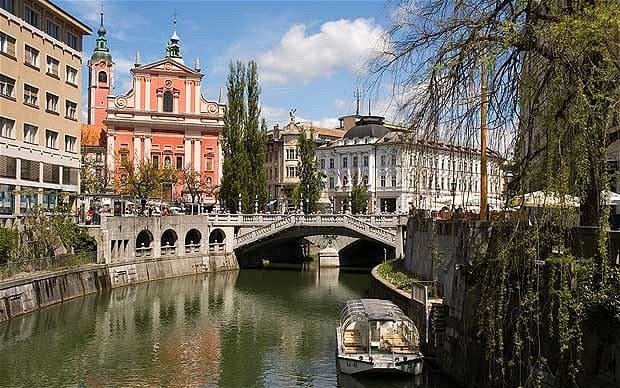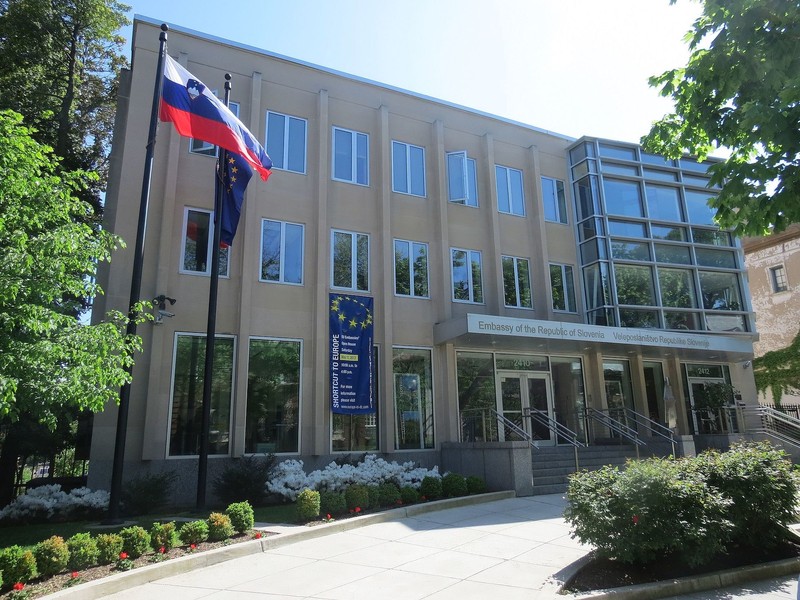Embassy of Slovenia
Introduction
Text-to-speech Audio
Slovenian-American relations date to the late 1700s, when the first Slovenian immigrants came to the United States. However, the United States did not formally recognize Slovenia until April 7, 1992. Since then, Slovenia and the United States have developed strong relations on a range of issues. The Embassy of Slovenia actively promotes relations with the United States along with Slovenian culture and language.
Images
Pictured is the capital of Slovenia: Ljubljana. The city has a population of 300,000 and can be navigated on foot. There are many cafes and other activities to partake in. Dubbed "mini-Prague", you can see the Julian Alps when the skies are clear.

The Slovenian Embassy is located on Embassy Row.

This flag was adopted in 1991. The coat of arms includes an image of Mount Triglav, the country's highest peak. The blue represents local rivers and the Adriatic Sea. The three colors have represented Slovenian unity since the nineteenth century.

Backstory and Context
Text-to-speech Audio
Located in central Europe, Slovenia home to around 2 million citizens, most of whom are ethnic Slovenes sharing a distinct culture and the Slovene language. Since declaring independence from Yugoslavia in 1991, Slovenia has advocated for strong relations with allies including the United States. Together, the countries promote peace, political and economic stability, science, and education. In 2004, Slovenia joined the European Union and North Atlantic Treaty Organization (NATO). Since joining NATO, Slovenia have contributed military forces on multiple occasions. Slovenia is actively participating in operations such as the NATO Stabilization Force in Bosnia and Herzegovina and the NATO Kosovo Force. Slovenia's concerns about the proliferation of nuclear weapons has led to their signing of more than a dozen international anti-terrorism conventions. Slovenia is among the countries whose citizens have visa-free travel to the United States.
Most Slovenian immigrants traveled to the United States between 1880-1914 and 1949-1956. During the early 1900s, the majority of those living in Slovenian communities around the United States were born in their home country of Slovenia. However, now the majority of those living in Slovenian communities are American-born. During the 2000 census, about 175 citizens claimed to be of Slovene descent. Currently, the majority of Slovenians live in Ohio, Pennsylvania, Illinois, Minnesota, Wisconsin, and California. To accommodate Slovenian citizens and promote Slovenian culture in the United States, there are consulates located in Pittsburgh, Cleveland, Atlanta, Denver, Hololulu, Miami Beach, San Fransisco, St. Paul, Michigan, Kansas, and Illinois, along with two consulates in Mexico.
Long before Slovenia was its own independent nation, the land that is present-day Slovenia was part of the Austro-Hungarian Empire. It remained part of the Austro-Hungarian Empire until the close of World War I. However, that nation created was not Slovenia; Yugoslavia was created by the Slovenes, the Serbs, and the Croats in 1929. After World War II, Yugoslavia became part of the Soviet Union's sphere of influence. Slovenia became an independent nation in June 1991. The Embassy of Slovenia in Washington, D.C. hosts events highlighting Slovenian music, film, dance, art, and food. The chancery is often open to the public for these events along with the popular EU Open House.
Most Slovenian immigrants traveled to the United States between 1880-1914 and 1949-1956. During the early 1900s, the majority of those living in Slovenian communities around the United States were born in their home country of Slovenia. However, now the majority of those living in Slovenian communities are American-born. During the 2000 census, about 175 citizens claimed to be of Slovene descent. Currently, the majority of Slovenians live in Ohio, Pennsylvania, Illinois, Minnesota, Wisconsin, and California. To accommodate Slovenian citizens and promote Slovenian culture in the United States, there are consulates located in Pittsburgh, Cleveland, Atlanta, Denver, Hololulu, Miami Beach, San Fransisco, St. Paul, Michigan, Kansas, and Illinois, along with two consulates in Mexico.
Long before Slovenia was its own independent nation, the land that is present-day Slovenia was part of the Austro-Hungarian Empire. It remained part of the Austro-Hungarian Empire until the close of World War I. However, that nation created was not Slovenia; Yugoslavia was created by the Slovenes, the Serbs, and the Croats in 1929. After World War II, Yugoslavia became part of the Soviet Union's sphere of influence. Slovenia became an independent nation in June 1991. The Embassy of Slovenia in Washington, D.C. hosts events highlighting Slovenian music, film, dance, art, and food. The chancery is often open to the public for these events along with the popular EU Open House.
Sources
Slovenian Community in the United States. Republic of Slovenia Ministry of Foreign Affairs. Accessed April 06, 2017. http://www.washington.embassy.si/index.php?id=424&L=1.
Bridge, Adrian. Ljubljana, Slovenia: the Perfect Break. Travel. April 20, 2011. Accessed April 06, 2017. http://www.telegraph.co.uk/travel/citybreaks/8463302/Ljubljana-Slovenia-the-perfect-break.html.
Political Affairs. Republic of Slovenia Ministry of Foreign Affairs. Accessed April 06, 2017. http://www.washington.embassy.si/index.php?id=389&L=1.
The World Factbook: Slovenia. Central Intelligence Agency. January 12, 2017. Accessed April 06, 2017. https://www.cia.gov/library/publications/the-world-factbook/geos/si.html.
U.S. Department of State. “A Guide to the United States’ History of Recognition, Diplomatic, and Consular Relations, by Country, since 1776: Slovenia.” Office of the Historian. Accessed November 2017. https://history.state.gov/countries/slovenia
U.S. Department of State. “U.S. Relations with Slovenia.” Bureau of European and Eurasian Affairs. July 21, 2016. Accessed November 2017. https://www.state.gov/r/pa/ei/bgn/3407.htm
Images:
"Embassy of Slovenia in Washington, D.C." Photo. 2013. Wpwashington. Wikimedia Commons. Accessed November 2017. https://en.wikipedia.org/wiki/Embassy_of_Slovenia_in_Washington,_D.C.#/media/File:Slovenian_Embassy_...
Bridge, Adrian. Ljubljana, Slovenia: the Perfect Break. Travel. April 20, 2011. Accessed April 06, 2017. http://www.telegraph.co.uk/travel/citybreaks/8463302/Ljubljana-Slovenia-the-perfect-break.html.
Political Affairs. Republic of Slovenia Ministry of Foreign Affairs. Accessed April 06, 2017. http://www.washington.embassy.si/index.php?id=389&L=1.
The World Factbook: Slovenia. Central Intelligence Agency. January 12, 2017. Accessed April 06, 2017. https://www.cia.gov/library/publications/the-world-factbook/geos/si.html.
U.S. Department of State. “A Guide to the United States’ History of Recognition, Diplomatic, and Consular Relations, by Country, since 1776: Slovenia.” Office of the Historian. Accessed November 2017. https://history.state.gov/countries/slovenia
U.S. Department of State. “U.S. Relations with Slovenia.” Bureau of European and Eurasian Affairs. July 21, 2016. Accessed November 2017. https://www.state.gov/r/pa/ei/bgn/3407.htm
Images:
"Embassy of Slovenia in Washington, D.C." Photo. 2013. Wpwashington. Wikimedia Commons. Accessed November 2017. https://en.wikipedia.org/wiki/Embassy_of_Slovenia_in_Washington,_D.C.#/media/File:Slovenian_Embassy_...
